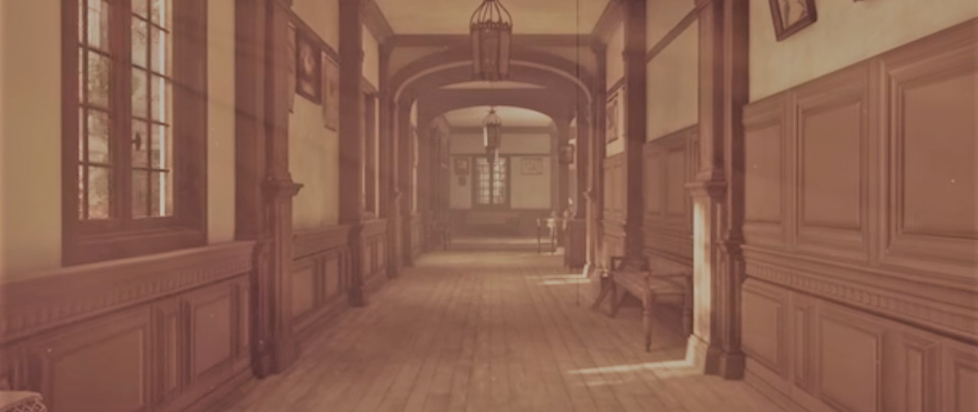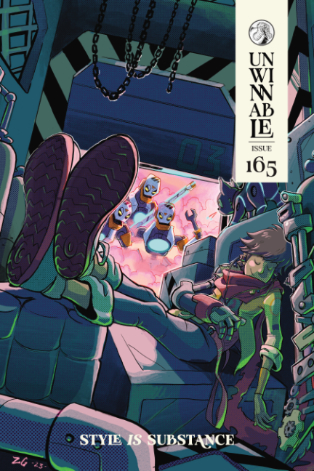
Uprooting Time

This column is a reprint from Unwinnable Monthly #165. If you like what you see, grab the magazine for less than ten dollars, or subscribe and get all future magazines for half price.
———
Analyzing the digital and analog feedback loop.
———
Content Warning: mention of residential schools.
Please bear with me. I feel like staying in the faerie realm a little longer. I know that’s a perilous choice, as time is unreliable there and it’s just past midsummer too; a sprightly period for the fae. But honestly, in recent years the concept of time as an abstract social construct has become increasingly mundane. People have written whole books about it, one of the most recent being Jenny Odell’s Saving Time: Discovering a Life Beyond the Clock, which focuses on how a lot of our time and space is organized, unsurprisingly, by capitalist principles. Perhaps we’re all fae-touched in that sense.
Or maybe the veil separating the Otherworld from ours is even thinner than we first imagined. Perhaps that’s part of why a lot of us are so enamored with all things liminal in our current era. At the risk of sounding like a transhumanist, the boundaries between the organic and digital have also grown hazier too. We map our online processes onto our offline lives more often than not and record everyday minutiae across several social media platforms. Faeries and the concept of the EcoGothic, now that I’ve become more acquainted with it, help me navigate these strange and ever-changing horizons.
In my last column for the myths and legends issue, I took a look at how games like Folklore encapsulate what I love about dark faerie stories that communicate how human existence is part of an interconnected web of nature, scientific inquiry and myth-making. From Software, unsurprisingly, is perhaps the only other studio to have portrayed faerie in the same EcoGothic manner that I loved about Folklore. They have a unique understanding of how to construct environments so that we are conscious not only of how we perceive places but our positioning within those places. Their experimental 2018 VR title, Déraciné (French for “Uprooted”, evoking the idea of changelings and forcible detachment from the natural world), is a good example of this. The title’s tone is somewhat of a departure for From Software, and the best way I can describe it is a Dark Academia remix of a Frances Hodgson Burnett story.

The basic conceit and synopsis of the game is that you are an invisible faerie that plays tricks on and aids the children of an orphanage. These orphans are dealing with the legacy of a group of scholars who want to use them to become powerful faeries themselves who can manipulate time. In the light of recent and ongoing discoveries of thousands of unmarked graves of children who were separated from their families and horribly mistreated in so-called residential schools throughout North America, the game’s narrative (though unintentional) touches on a uniquely heavy and disturbing valence in current events. But Déraciné makes a point of delineating its ethics, more so than Soulsborne games do. For instance, faeries are described in the trailer as “[wondrous] creatures who live in a world where time stands still”. But they are revealed throughout the game to be more sinister than this initial impression, with faeries sustaining their power by draining the life force of other beings. Many of the gameplay sequences are handled like tableaux vivants (theatrical living images), with the characters only moving once you’ve manipulated some object in the game world.
The main theme of the game, Miyazaki has previously discussed, deals with perceptions of existence versus non-existence, time and the way that we account for our actions in the present knowing that we might not live to see the repercussions of them. The EcoGothicism of Déraciné lies in this concept of being an entity capable of stealing others’ time to prolong one’s own. Research findings on the faerie experiment late in the game proclaim that those who commit this act “will turn themselves into something else entirely.” Commodified time is unnatural, in other words, and trying to exert control over it and forcibly extract time from others connects with a capitalistic fear of not being the master of nature.
Although this game predates the COVID-19 pandemic, there’s an interesting aside to be made here about how during quarantine times such tableaux became popular to enact at home as a way to engage with art in a more immediate way than online virtual museums which proliferated during that time. These tableaux vivants also make me think of how everyone, whether they considered themselves high-brow or not, during pandemic quarantine or lockdown times grew intimate with how surreal everyday experiences that were supposedly timebound are.

This game will frustratingly probably remain an untouchable art object for me, as there’s very little chance of me jumping through the technical (and financial) hoops involved to access this unique PSVR title. That doesn’t stop me from admiring it from afar, however, like some sort of ludonarrative will-o’-the-wisp. Usually I don’t prefer to experience (or analyze) games that I haven’t been able to play or co-play with someone else. I make an exception for Déraciné not only for accessibility’s sake, but because I’m inexorably drawn to media and texts with rhizomatic inspirations. And dark stories involving the fae or the supernatural, of course.
Miyazaki’s idea of the fae is inspired by old Celtic myths and the poetry and philosophy of Fiona Macleod. Macleod was actually a pseudonym created by the late Victorian writer William Sharp, who took on the persona of a woman to write about themes connected to the Celtic Renaissance of the period. Macleod/Sharp and other figures of this movement also produced a short-lived bi-annual magazine called The Evergreen: A Northern Seasonal which dealt with the concept of urban renewal and concerns about how the modern world treats nature through a holistic design brief. There were only four volumes, to represent the four seasons, and every graphic and selection curated for the volumes spoke to macro and micro details of the natural world. I’m not surprised at all that someone as detail-oriented as Miyazaki found rich material for his VR project in Macleod/Sharp and their work’s ethos.
Time and our place in it are germane to not just narrative design but the general design of games and how we experience that. Players often talk about how many hours they sunk to complete a game. Competitive speedrunners try to distill their intense understanding of game mechanics into an ever smaller timestamp. Keith Stuart, mentioned in one Pushing Buttons newsletter of his that he often remembers less about the games he’s played over the years and recalls more what was happening around the gameplay. I know some people are probably tired of hearing me reiterate this in practically any discussion of game design, but it bears repeating (especially with game culture’s fixations on anything “next gen”) that games are always rooted to their zeitgeist both aesthetically and mechanically.
With more specific regard to place or in particular placement, there’s certain positionings of a player in relation to the game world’s space that is naturally conceived of, right? Like when you want to represent a player that’s closer (both physically and mentally) to the POV character within a game or perhaps a being possessing exceptional personal agency, you go with a first-person perspective like in Déraciné (or practically every shooter). Isometric makes sense for strategy games because it approximates that war table perspective of being a general or chess master moving their key pieces and such across a map. Isometric also evokes classic board games like Risk and more recent titles like Pandemic. Third person lends itself well for open world games because they give you a sense of being part of an adventure or an experience that’s bigger than yourself.

Part of the continuing wonder of the current era of Zelda games is that they impart a palpable sense of wonder at being a small actor in a complete secondary world that feels alive. I just spoke recently with a coworker at one of my day jobs who’s a longtime player of Breath of the Wild that discovered new places and experiences in that game even as Tears of the Kingdom was being released last month and how in awe they were at the sheer size of Hyrule.
There’s obviously been major downsides to third person open-world design laid bare by Elden Ring in recent years as well. Many western developers are stuck in a rut of deriving from the Ubisoft standard of open-world design without deviating much from its principles such as having in-depth UI tools and a very defined set of objectives. Elden Ring reimagined open-world games in a way that freed up the player’s sense of not just what an open-world could feel like, but what the third person perspective could feel like as well. I feel that Déraciné also does this for VR. In a series of videos about Déraciné’s gameplay and lore, prominent Soulsborne video essayist VaatiVidya mentions that they appreciate how From Software aligns their game design parallel to the player’s experience.
As much as I’m not a naysayer of VR, as this perspective has a lot of potential for stories like Déraciné’s which rely heavily on a sense of place and of being an entity within that place, I’m skeptical. Do we really need to feel like we’re truly enveloped in a game’s world, like a holodeck? What works for Déraciné and its faerie lore is that despite one of its core objectives being to convince the orphans that you are real, you and the other faeries are never truly perceived in the game world. Miyazaki chose a faerie as his protagonist figure because it was a being that is often invisible to the human world and gets that uncanny feeling of acting upon a world that can only be made to artificially perceive you.
Déraciné is an interesting rumination on what makes game narratives convincing, but it’s also a game that effectively communicates EcoGothic fears of being at the mercy of nature. I wonder what a game like this would play like if it communicated non-Western EcoGothic fears, of those dealing with the aftermath of Western humans commodifying nature and trying to control every aspect of it.
———
Phoenix Simms is a writer and indie narrative designer from Atlantic Canada. You can lure her out of hibernation during the winter with rare McKillip novels, Japanese stationery goods, and ornate cupcakes.




